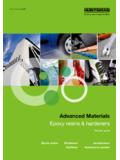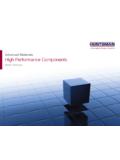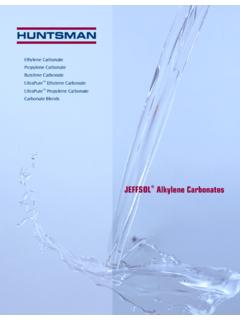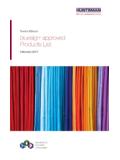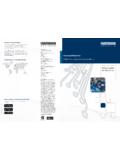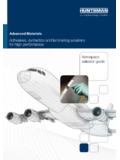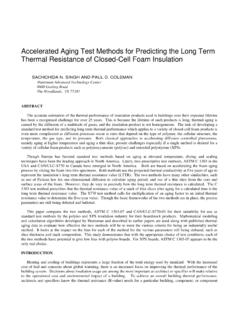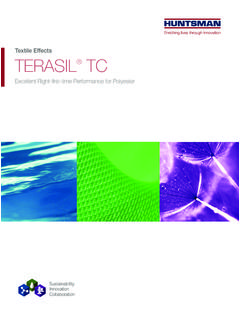Transcription of Acceleration of Epoxy Resin Systems - Huntsman …
1 Bruce L. Burton Huntsman Corp. 1 August 15, 2013 Acceleration of Amine-Cured Epoxy Resin Systems Bruce L. Burton, Principal Scientist Huntsman Corporation 8600 Gosling Road The Woodlands, Texas 77381 Office phone: 281-719-7487 Presented at a meeting of the Thermoset Resin Formulators Association at the Hyatt Regency Newport Hotel in Newport, Rhode Island, September 29 through October 1, 2013 This paper is presented by invitation of TRFA. It is publicly distributed upon request by the TRFA to assist in the communication of information and viewpoints relevant to the thermoset industry.
2 The paper and its contents have not been reviewed or evaluated by the TRFA and should not be construed as having been adopted or endorsed by the TRFA. Bruce L. Burton Huntsman Corp. 2 Acceleration of Amine-Cured Epoxy Resin Systems Abstract: The choice of accelerators for amine-cured Epoxy formulations is sometimes done as an afterthought, using old accelerator compounds or packages designed for other purposes. Such an approach to Acceleration may eventually create problems in the final products that, in some cases, may never be traced back to the accelerator.
3 Properly used accelerators can be an integral part of fine-tuning the reactivity of slower reacting Resin formulations and can also serve to beneficially influence properties such as glass transition temperature, modulus, strength, elongation at break, and chemical resistance. In Epoxy formulations that utilize amine curatives, accelerators typically increase the reaction rate by 1) adding, or quickly creating, hydroxyl groups, 2) increasing the heat generated (thus increasing the temperature) in the system , or both. If Acceleration alone were needed in all applications, one would just use the necessary amount of the fastest accelerator.
4 However, other factors, such as cost, toxicity, solubility, processing effects, final properties, regulatory concerns, ease of use, and amine-blushing mean that it can be advantageous to select specific accelerators that are well-matched to or designed for specific applications. Introduction: The terminology used for accelerators is varied and may sometimes cause confusion since the terms accelerator, catalyst, promoter, initiator, dryer, etc., are sometimes used loosely even though they can apply to very specific types of materials having distinctly different characteristics and functions.
5 This article focusses on amine-cured Epoxy Resin Systems and the term accelerator is used to describe a variety of compounds and mixtures used to increase the reaction rate, whatever the mechanism. Over several decades, many papers have been published on Epoxy accelerators [1, for example] with relatively few of them offering broad practical advice. This paper is intended to provide a useful basis of understanding various ways of increasing the curing speed of Epoxy Systems while avoiding the confusion and pitfalls that may arise due to unexpected effects that can occur when accelerators developed for certain applications or curing conditions are used in very different circumstances.
6 The dual purposes of creating easily made formulations and designing experiments to highlight fundamental trends can be at odds with one another, though in this work addressing both needs is attempted. The choice of accelerators for amine-cured Epoxy formulations has often been done as an afterthought, using old accelerator compounds or packages designed for other purposes. Such an approach to Acceleration can create problems. This can occur, for example, when compounds like tris-(dimethylaminomethyl) phenol ( DMP-30) or benzyl dimethylamine ( BDMA or dimethylbenzylamine) Bruce L.
7 Burton Huntsman Corp. 3 are used with amine curing agents rather than anhydride curing agents. These materials can create issues of odor, handling, yellowing, brittleness, and/or Tg (glass transition temperature) loss. It may also be that Epoxy homopolymerization caused by such accelerators can limit some types of mechanical performance. Problems may be avoided or minimized by carefully evaluating and choosing from among the various accelerators available in the marketplace. Accelerators typically increase the reaction rate of Epoxy Systems by 1) adding, or quickly creating, hydroxyl groups, 2) by increasing the heat generated (thus increasing the temperature) in the system , or both.
8 If only Acceleration mattered, one would just use the necessary amount of the fastest accelerator. However, other factors, such as cost, toxicity, solubility, processing effects, final properties, regulatory concerns, and ease of use, mean that it can be advantageous to select specific accelerators that are well-matched to particular applications. For instance, careful pairing of accelerators with slowly reactive polyetheramines may allow the use of higher processing temperatures, thereby decreasing the need for Epoxy diluents that may decrease thermal and mechanical performance properties and increase cost.
9 Properly chosen accelerators, and their use levels, can be an integral part of fine-tuning the reactivity of Epoxy Systems and can also serve to beneficially influence properties such as glass transition temperature, modulus, strength, elongation at break, and chemical resistance. Accelerators well-suited to some applications, like composite molding, may not fare as well in other applications such as ambient-cure floor coatings. Accelerators Can Increase Options for Resin Choice and Processing Standard liquid Epoxy resins (such as ARALDITE GY 6010 Epoxy , EPON 828 Epoxy , 331 Epoxy , etc.)
10 All contain low levels of hydrolyzed Epoxy groups ( glycol end groups) which serve to 1) increase the reactivity of the resins toward amine hardeners, 2) greatly increase viscosity of the resins, and 3) prevent crystallization of the resins. The hydrolyzation is readily done at the end of the Resin production process using acid and heat. Over time, such partially hydrolyzed DGEBA resins became the standard bisphenol A Epoxy or liquid Epoxy Resin ( ) type Resin , as it met the requirements of the broadest assortment of end-users. Although these higher viscosity hydrolyzed resins are needed for some applications, other applications, such as the molding of large composites, greatly benefit from the use of lower viscosity, slower reacting non-hydrolyzed resins.
